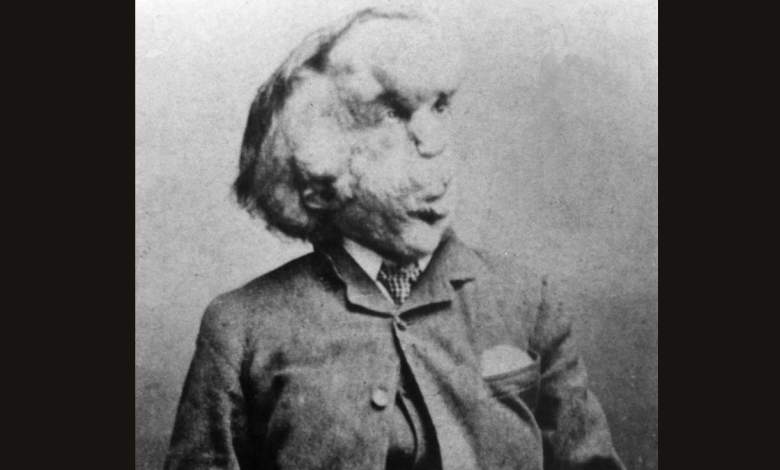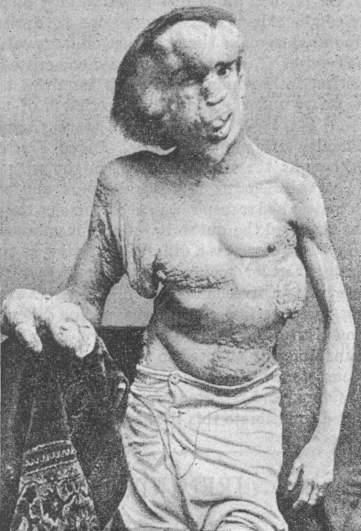
Wikicommons: Photographer: Unknown Joseph Merrick
Author Jo Vigor-Mungovin says that she has discovered the grave of Joseph Merrick. Born in the mid-1800’s, Merrick was so severely deformed, he was referred to as the “Elephant Man.” Sometimes mistakenly called “John,” the highly intelligent and sensitive Merrick was unable to work due to his disabilities and eventually could only earn money as a popular sideshow curiosity. Merrick may have died in 1890 but the story of his life continues to fascinate the public.
Vigor-Mungovin has written Joseph: The Life and Times of the Elephant Man, a 2016 biography of Merrick. As part of her continued research, Vigor-Mungovin was determined to find Merrick’s gravesite. After an exhaustive review of cemetery records, Vigor-Mungovin feels she is 99% sure she has located the spot where Merrick’s remains are buried.
Here’s what you need to know about Joseph Merrick and Jo Vigor-Mungovin
1. Merrick Seemed Healthy When he was Born

Photographer unknown/wikicommonsJoseph Merrick did not show any signs of deformity until he was about five years old.
Merrick was born on August 5, 1862 in the city of Leicester and by all accounts appeared to be a healthy baby. But by the time he was five years old, he started to develop abnormally. Researchers believe Merrick suffered from Proteus Syndrome, a rare genetic condition that causes overgrowth of skin, bones, muscles, and fatty tissues. In 2013, a DNA test was performed on Merrick’s bones and hair to confirm the diagnosis of Proteus Syndrome, but the results were inconclusive.
Merrick’s mother died when he was 11. By the time he was 17, his father had remarried and rejected him, forcing him to enter the Leicester Public Workhouse to find houisng and employment. Over time, Merrick’s condition worsened, making it difficult to perform any sort of manual labor. With few options, he approached showman Sam Torr and asked to be put on display.
While in London, Torr asked fellow showman Tom Norman to promote and exhibit Merrick. It was at Norman’s shop that Dr. Frederick Treves befriended the disfigured young man. Treves wrote that Merrick was “the most disgusting specimen of humanity that I had ever seen … at no time had I met with such a degraded or perverted version of a human being as this lone figure displayed.” The two remained friends until Merrick’s death in 1890 at the age 27.
2. Merrick Spent His Last Years Living at the Royal London Hospital
After traveling as a sideshow curiosity for two years, Merrick wound up back in London, destitute after being robbed of all of his money. Finding Dr. Treve’s calling card in Merrick’s belongings, the police were able to bring Merrick to the Royal London Hospital where Treves was a physician, and have Merrick temporarily admitted as a patient. Treves saw that Merrick’s condition had deteriotedly dramatically and would require constant medical treatment.
Realizing that Merrick needed a permanent place to live and would require food and care, the hospital’s chairman, Francis Carr-Gomms, wrote a public appeal that was published in the newspaper, The Times. Carr-Gomms’ impassioned letter raised enough money for Merrick to reside at the hospital for the remainder of his life. Merrick was moved to the hospital’s east wing basement, where he was provided with living quarters, food and nursing care.
But Merrick was not confined to his hospital quarters. He was known to have enjoyed attending the theatre on occasion and taking walks in the country to pick wildflowers. He was also a minor celebrity among London’s high society. While residing at the hospital, he had the opportunity to meet Queen Alexandra and other prominent individuals, including the famed British actress, Madge Kendal.
3. There’s a Push for Merrick’s Remains to be Buried in his Birthplace of Leicester
It’s believed Merrick, whose head was extremely large and heavy, died on April 11, 1890 from accidental asphyxiation resulting from dislocating his neck while trying to lay his head down to sleep in a normal position. After his death, Treves dissected Merrick’s body, keeping the skeleton for medical research. His soft tissue remains were then buried but there was no hospital record of where his remains were interred.
On May 5, 2019, Vigor-Mungovin revealed that she had found the burial site of Merrick’s soft tissue. “A message on her social media read: ‘Today after weeks of emails, research & visits to the #CityofLondonCemetery the final resting place of #JosephMerrick has been located,” she wrote on social media. With several cemeteries so close together, Vigo-Mungovin researched burial records that would have fallen within eight weeks of his death. She eventually found a match at the City of London Cemetery.
Merrick’s skeleton was eventually mounted and is currently on private display for medical students and physicians at the Royal London Hospital Museum. Although Merrick’s actual skeleton is not available for public viewing, his personal possessions and a replica of his skeleton can be seen in a room open to the public.
Merrick was known to be a very devout Christian. Showman Tom Norman’s granddaughter Valerie Howkins has spoken out on the subject with the BBC in 2016. “There was just no question when he died that he would go back to Leicester to be buried,” she said. It’s just so sad that he had his flesh stripped from his bones and has been mounted in a glass cabinet for 120 years against his will. He was Christian and would have expected a Christian burial,” she added.
4. Merrick’s Life Has Been Portrayed by Actors Including John Hurt, Bradley Cooper, Mark Hamill, and David Bowie.
In 1977 there was increased interest in Merrick’s life after the opening of The Elephant Man, a play by Bernard Pomerance about Merrick’s life. Actors who have played Merrick on stage include Bradley Cooper, Mark Hamill, and David Bowie. John Hurt played Merrick in the hugely successful 1980 David Lynch film by the same name.
Cooper claims that it was John Hurt’s portrayal of Merrick in the film that made him consider becoming an actor. “Oh, it was that movie, when I was a kid. The Elephant Man. John Hurt. That was the crystalized moment, where I thought, Oh, I really need to do this for a living,” he told Deadline.
Hurt also discussed how learning about Merrick impacted him and what it was like portraying such a misunderstood man. “There is a dignity to him…there has to be a dignity to him,” he said.
5. Proteus Syndrome Can be Managed and There are Treatments on the Horizon
While DNA tests on Merrick’s remains may not have been definitive, medical experts are fairly certain he suffered from Proteus Syndrome. The condition results from a mutation in the AKT1 gene and is incredibly rare. The National Institutes of Health estimate that only one in a million people are born with this condition. The Proteus Syndrome can only be diagnosed by genetic testing.
The condition derives its name from the Greek god of change Proteus, because the patient’s body is constantly changing due to overgrowths of skin, bone and other tissues. Individuals living with Proteus Syndrome typically require treatment from several physicians including orthopedic specialists, geneticists, internists and hematologists.
According to the Proteus Syndrome Foundation, each patient must be treated uniquely. Clinical trials to treat Proteus Syndrome are currently underway. Some medications are showing promise. In April 2019, it was announced that a new drug may have some success in halting the disease’s uncontrolled growth.
